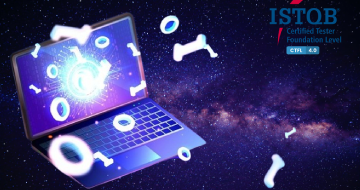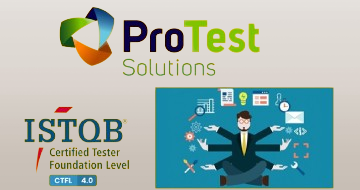IIRF Online > Development > Software Testing > ISTQB Certified Tester Foundation Level (CTFL) > ISTQB Foundation Level V4.0 Complete Training
ISTQB Foundation Level V4.0 Complete Training by Udemy
The best way to prepare for the ISTQB Foundation Level V4.0 Exam
Course Highlights
- ISTQB Foundation Level Syllabus Content
- Black Box & White Box Techniques
- Difference between Static Testing & Dynamic Testing
Skills you will learn!
Curriculum
9 Topics
Introduction
Introduction
A Very Important Update
Target Audience
Target Audience
What is ISTQB? and what are the certificates that it offers?
Course Content
Exam Structure
Course Slides
69 Topics
What is Software Testing
What is Software Testing
Misperceptions of Testing
Misperceptions of Testing
Objectives of Testing
Objectives of Testing
Difference between Testing & Debugging
Difference between Testing & Debugging
1.1 Questions & Answers
Why is Testing necessary
Why is Testing necessary
Tester's Contribution to Success
Tester's Contribution to Success
Difference between Quality Assurance & Quality Control
Difference between Quality Assurance & Quality Control
Errors Defects & Failures
Errors Defects & Failures
Why do errors happen
Why do errors happen
False Positive & False Negative
False positive & False negative
Root Cause Analysis & Process Improvement
Root Cause Analysis & Process Improvement
Why is Testing Necessary
1.2 Questions & Answers
Testing Shows Presence of Defect | Principle #1
Testing Shows Presence of Defects
Exhaustive Testing is Impossible | Principle #2
Exhaustive Testing is Impossible
Early Testing saves Time & Money | Principle #3
Early Testing
Defects Cluster Together | Principle #4
Defects Cluster Together
Beware of Pesticide Paradox | Principle #5
Beware of Pesticide Paradox
Testing is Context Dependent| Principle #6
Testing is Context Dependent
Absence of Error is a fallacy| Principle #7
Absence of Error is a fallacy
1.3 Questions & Answers
Seven Testing Principles
Test Process Introduction
Test Process Introduction
Test Planning | Test Process Step #1
Test Planning | Test Process Step #1
Test Monitoring & Control | Test Process Step #2
Test Monitoring & Control | Test Process Step #2
Test Analysis | Test Process Step #3
Test Analysis | Test Process Step #3
Test Design | Test Process Step #4
Test Design | Test Process Step #4
Test Implementation | Test Process Step #5
Test Implementation | Test Process Step #5
Test Execution | Test Process Step #6
Test Execution | Test Process Step #6
Test Completion | Test Process Step #7
Test Completion | Test Process Step #7
Testing Work Products
Testing Work Products
1.4 Questions & Answers
Test Process
Psychology of Testing
Psychology of Testing
Ways to communicate well
Ways to communicate well
Tester's mindset
Tester's mindset
1.5 Questions & Answers
Psychology of Testing
16 Topics
1.1 What is Testing Question #1
1.1 What is Testing Question #2
1.1 What is Testing Questions #3-5
1.1 What is Testing Questions #6-7
1.1 What is Testing Questions #8-11
1.2 Why is Testing Necessary Questions #1-3
1.2 Why is Testing Necessary Questions #4-6
1.2 Why is Testing Necessary Questions #7-12
1.2 Why is Testing Necessary Questions #13-18
1.2 Why is Testing Necessary Questions #19-24
1.3 Seven Testing Principles Questions #1-5
1.3 Seven Testing Principles Questions #6-8
1.4 Test Process Questions #1-6
1.4 Test Process Questions #7-12
1.4 Test Process Questions #13-18
1.5 Psychology of testing Questions #1-5
43 Topics
Software Development Lifecycle Models
Software Development Lifecycle Models
Sequential VS. Iterative & Incremental models
Sequential VS. Iterative & Incremental Models
Waterfall Model
Waterfall Model
V-Model
V-Model
Rational Unified Process
Rational Unified Process
Scrum Methodology
Scrum Methodology
Kanban
Kanban
Spiral Model (Prototyping)
Spiral Model (Prototyping)
2.1 Questions & Answers
Software Development Lifecycles
Test Levels
Test Levels
Component Testing
Component Testing
Integration Testing
Integration Testing
System Testing
System Testing
Acceptance Testing
Acceptance Testing
2.2 Questions & Answers
Functional Testing
Functional Testing
Non-functional Testing
Non-functional Testing
Structural-based Testing
Structural-based Testing
Change-related Testing
Change-related Testing
2.3 Questions & Answers
Maintenance Testing
Maintenance Testing
Impact Analysis
Impace Analysis
2.4 Questions & Answers
8 Topics
2.1 Software Development Lifecycle Models Questions #1-3
2.1 Software Development Lifecycle Models Questions #4-6
2.2 Test Levels Questions #1-4
2.2 Test Levels Questions #5-7
2.3 Test Types Questions #1-5
2.3 Test Types Questions #6-10
2.3 Test Types Questions #11-14
2.4 Maintenance Testing Questions #1-7
15 Topics
Static Analysis & Review Definition
Static Analysis & Review Definition
Benefits of Static Testing
Benefits of Static Testing
3.1 Questions & Answers
Review Process Introduction
Review Process
Review Process
Review Roles & Responsibilities
Review Roles & Responsibilities
Review Types
Review Types
Review Techniques
Review Techniques
3.2 Questions & Answers
5 Topics
3.1 Static Testing Basics Questions #1-6
3.2 Review process Questions #1-6
3.2 Review process Questions #7-13
Review Types Questions #1-7
Review Techniques Questions #1-4
3 Topics
Categories of Test Techniques
Categories of Test Design Techniques
4.1 Questions & Answers
14 Topics
Equivalence Partitioning
Equivalence Partitioning
Equivalence Partitioning Questions & Answers
Boundary-value Analysis
Boundary-value analysis
Boundary-value Analysis Questions & Answers
Decision Table Testing
Decision Table Testing
Decision Table Testing Questions & Answers
State Transition Testing
State Transition Testing
State Transition Testing Questions & Answers
Use Case Testing
Use Case Testing
30 Topics
Equivalence Partitioning Example #1
Equivalence Partitioning Example #2
Equivalence Partitioning Example #3
Equivalence Partitioning Example #4
Equivalence Partitioning Example #5
Equivalence Partitioning Example #6
Equivalence Partitioning Example #7
Equivalence Partitioning Example #8
Equivalence Partitioning Example #9
Equivalence Partitioning Example #10
Equivalence Partitioning Example #11
Equivalence Partitioning Example #12
Equivalence Partitioning Example #13
Boundary-value Analysis Example #1
Boundary-value Analysis Example #2
Boundary-value Analysis Example #3
Boundary-value Analysis Example #4
Boundary-value Analysis Example #5
Boundary-value Analysis Example #6
Decision Table Testing Example #1
Decision Table Testing Example #2
State Transition Testing Example #1
State Transition Testing Example #2
State Transition Testing Example #3
State Transition Testing Example #4
State Transition Testing Example #5
State Transition Testing Example #6
State Transition Testing Example #7
State Transition Testing Example #8
State Transition Testing Example #9
6 Topics
Statement Coverage
Statement Coverage
Statement Coverage Questions & Answers
Decision Coverage
Decision Coverage
Decision Coverage Questions & Answers
2 Topics
Experience-based Techniques
Experience-based Techniques
30 Topics
Chapter 5 Introduction
Independent Testing
Benefits & Drawbacks of Independence
Tasks of Test Manager & Tester
Test Organization
5.1 Questions & Answers
Test Planning & Estimation
Purpose & Content of a Test Plan
Test Plan Template
Test Strategy & Test Approach
Entry Criteria & Exit Criteria
Test Execution Schedule
Factors Influencing the Test Effort
Test Estimation Techniques
Test Planning & Estimation
5.2 Questions & Answers
Test Monitoring & Control
Metrics used in Testing
Purposes Contents and Audiences for Test Reports
Sample Testing Report
5.3 Questions & Answers
Test Monitoring & Control
Configuration Management
Configuration Management
Risks & Testing
Risk & Testing
5.5 Questions & Answers
Defect Management
Defect Management
5.6 Questions & Answers
6 Topics
5.1 Test Management Questions #1-5
5.1 Test Management Questions #6-10
5.2 Test Planning & Estimation Questions #1-8
5.2 Test Planning & Estimation Questions #9-13
5.2 Test Planning & Estimation Questions #14-16
5.2 Test Planning & Estimation Questions #17-19
6 Topics
Test Tool Considerations
Test Tool Considerations
Test Tool Considerations
Effective Use of Tools
Effective Use of Tools
Effective Use of Tools
8 Topics
Questions 1 to 5
Questions 6 to 10
Questions 11 to 15
Questions 16 to 20
Questions 21 to 25
Questions 26 to 30
Questions 31 to 35
Questions 36 to 40
8 Topics
Questions 1 to 5
Questions 6 to 10
Questions 11 to 15
Questions 16 to 20
Questions 21 to 25
Questions 26 to 30
Questions 31 to 35
Questions 36 to 40
6 Topics
Questions 1 to 5
Questions 6 to 10
Questions 11 to 15
Questions 16 to 20
Questions 21 to 25
Questions 26 to 30
19 Topics
Introduction
What is Testing
Why is Testing Necessary
Seven Testing principles
Test Process
Psychology of Testing
Software Development Lifecycles
Test Levels
Types of Testing
Maintenance Testing
Static Testing Basics
Review Process
Categories of Test Design Techniques
Equivalence Partitioning
Boundary-value analysis
Test Organization
Test Planning & Estimation
Test Monitoring & Control
Risk & Testing
39 Topics
1.1 What is Testing [V4]
1.1 What is Testing [V4]
Testing is a set of Activities
Testing is a set of Activities
Validation & Verification
Validation & Verification
Dynamic Testing & Static Testing
Dynamic Testing & Static Testing
Systems thinking
Systems thinking
Test Objectives
Test Objectives
Testing & Debugging
Testing's Contribution to Success
QA & QC
Errors Defects Failures & Root causes
Testing shows presence of defects not their absence
Exhaustive Testing is impossible
Early Testing Saves Time & Money
Defects Cluster Together
Tests Wear Out
Testing is Context Dependent
Absence of Errors is a Fallacy
Test Activities
Test Planning
Test Monitoring & Control
Test Analysis
Test Design
Test Implementation
Test Execution
Test Completion
Test Process in Context
Testware: Test Planning Monitoring & Control Work Products
Testware: Test Analysis Design & Implementation Work Products
Testware: Test Execution & Completion Work Products
Traceability between Test Basis & Testware
Roles in Testing
Generic Skills required for Testing
Whole-Team Approach
13 Topics
Independence of Testing
Testing in the Context of the Software Development Lifecycle
Waterfall Model
V-Model
Iterative & Incremental Development
Software Development Methods & Practices
Impact of Software Development Lifecycle on Testing
Software Development Good Practices
Test-Driven Development
Acceptance Test-Driven Development
Behavior-Driven Development
DevOps & Testing
Shift-left Approach

ISTQB Foundation Level V4.0 Complete Training




